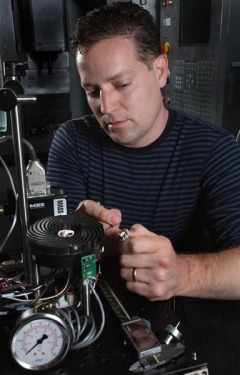 The power consumption of various chips and various devices continues to increase, and the radiators are also full of tricks. However, the most fundamental one is the air-cooled cooling. Water-cooled and the like cannot be popularized in the short term. The Sandia National Laboratories, a division of the US Department of Energy, recently proposed a new technology that promises to revolutionize the cooling and cooling landscape in the computing and microelectronics industries.
The power consumption of various chips and various devices continues to increase, and the radiators are also full of tricks. However, the most fundamental one is the air-cooled cooling. Water-cooled and the like cannot be popularized in the short term. The Sandia National Laboratories, a division of the US Department of Energy, recently proposed a new technology that promises to revolutionize the cooling and cooling landscape in the computing and microelectronics industries. This "Sandia Cooler" (Sandia Cooler) is also called "Air Bearing Heat Exchanger" (Air Bearing Heat Exchanger), the biggest feature is to make the stationary heat sink rotate at high speed.
Its developer Jeff Koplow said that the US IT industry now spends as much as $7 billion a year on electricity bills, and it continues to soar, and this type of radiator can significantly reduce the heat generated by processor chips in data centers and large-scale computing environments. The energy consumed also has broad prospects in personal computer applications.
The biggest heat-exchange bottleneck in a traditional CPU heatsink is the dead air boundary layer attached to the heat sink. In a Sandia heatsink, the heat passes through a narrow gap with a thickness of only 0.001 inch (25 microns) from standstill. The stationary base is efficiently transferred to the rotating heat sink structure. The air stationary boundary layer enveloping the heat sink has a powerful centrifugal pump effect, making the boundary thickness one-tenth that of normal conditions, thereby significantly improving the heat dissipation efficiency in a smaller space.
Heat-transfer heat sinks that rotate at high speeds also do not suffer from the problem of “smearingâ€, and do not accumulate a pile of difficult-to-remove dust over time like traditional radiators.
In addition, the way the heat sink cuts air has also been redesigned to greatly increase aerodynamic efficiency with minimal noise.
Laboratory researchers have validated the above concept on a proof-of-concept prototype, and the prototype has a size that is roughly the same as a normal CPU cooler.
Jeff Koplow claims that if it can control the volume better, it can reduce the electricity consumption in the United States by more than 7%.
Sandia Radiator has begun to seek commercial licensing cooperation, and also hope that this new technology can be put into practice as soon as possible.
LED Tube Light ,Indoor LED Spotlight ,LED Flood Lights ,LED Spotlight Bulbs
LED Street Light Co., Ltd. , http://www.nbledspotlight.com